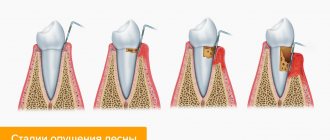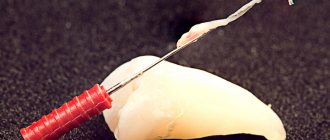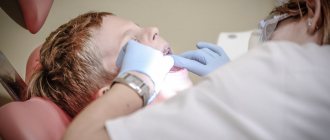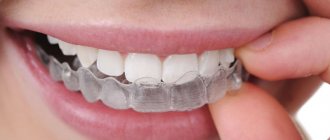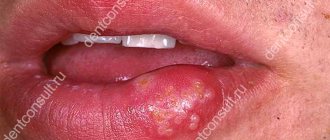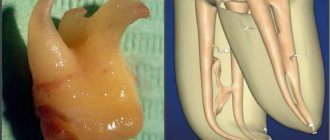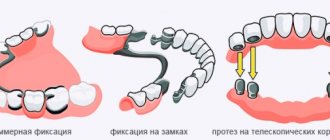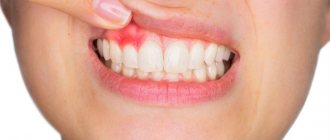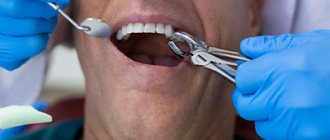Tooth roots inevitably begin to become exposed in old age - this process is completely natural and is a reaction to the aging of the body. But old age is far from the only reason for this phenomenon, which spoils a beautiful smile and can lead to other serious illnesses in the future. Root exposure can occur at any age due to disease or pathology.
This article will talk about what to do in a situation where the gum has noticeably risen above the tooth, and you will also find answers to why this happens and what the consequences of refusing treatment may be.
For what reasons are the roots of teeth exposed?
The phenomenon of exposed teeth in dentistry has a name - gum recession, but usually recession is only a symptom behind which another dental disease is hidden. Most often, it is the lower row of teeth that suffers from recession, since it bears the brunt of the load.
A common disease that causes gums to become exposed is periodontitis, during which inflammatory processes begin to occur in the periodontal tissues; if such a disease is started, it can become chronic.
Typically, periodontitis is a consequence of poor oral hygiene. Plaque and food debris that accumulate between the teeth and on the surface gradually enter the soft tissues and provoke inflammatory processes.
Inflammation significantly weakens the gums, making them weak and unable to maintain their shape. Then they descend and expose the neck of the teeth, which can lead to their loosening and loss. Periodontitis can also be caused by natural pathology.
The second most common cause of exposed roots is periodontal disease, which, unlike periodontitis, is not an inflammatory disease. During such a disease, the gums decrease in size due to atrophy of soft tissues, or disruption of metabolic processes in them.
Other reasons that cause denudation of teeth include:
- Improper brushing of teeth, namely too much pressure of the brush on the gums.
- Tooth decay close to the gums due to caries.
- Malocclusion, short frenulum of the tongue and other pathologies of the oral cavity.
- Malfunctions of the thyroid gland and gastrointestinal tract.
- Caries that has penetrated deep into the dental tissue often causes the gums to detach from the tooth.
To eliminate the defect, it is necessary to find out the cause of its occurrence. If the disease is allowed to progress, the gums will eventually recede to the point where the tooth can fall out. Considering that most of the causes of such a defect are not local, but affect the entire oral cavity, refusal of treatment can lead to the loss of all affected teeth.
Impacted third molars
- Lack of space leads to abnormal placement of the tooth in the jaw arch. Impacted teeth can grow towards the cheek and constantly injure its mucous membrane.
- In the absence of an antagonist in the opposite jaw, they cause serious malocclusion, ultimately leading to imbalance of the masticatory muscles, pinched nerve endings, dysfunction of the temporomandibular joint and even neurological disorder.
- A tooth that does not come out of the bone often provokes the formation of a follicular cyst, which does not manifest itself for a long time. This is explained by the presence of remnants of a follicle around it, the cells of which, for as yet unknown reasons, begin to multiply. The roots of the adjacent molar often get into the lumen of the cyst. This leads to necrosis of their pulp and necessitates the treatment of pulpitis and depulpation of the tooth.
- The third molar can put pressure on the roots of the second, causing headaches, soreness in the ear or throat.
Associated symptoms
The tooth consists of three parts:
- Crown.
- Neck.
- Root.
In a healthy state, only the crown should be visible, the neck should be covered by the gum, and the root should be located in the alveolus (a special recess for the root). When the process of recession begins, the neck of the tooth is exposed, but that’s not all; along with this problem, the following symptoms usually appear:
- High tooth sensitivity when in contact with extremely cold, hot, sweet, salty and sour foods, because the tooth exposed the sensitive part of the neck, on which there is almost no protective enamel.
- Noticeable darkening of the enamel spoils the appearance; the situation is also aggravated when the neck of the tooth, which is yellow, is exposed.
- Visually, the tooth appears longer.
- Feeling of discomfort in the gums. When you try to press on it with your tongue, it does not fit tightly to the tooth, but moves away from it.
- When brushing your teeth, your gums become very swollen, painful and red.
- Wide interdental gaps appear at the base of the tooth.
It should be noted that any of the above symptoms are more acutely felt in adolescence and middle age, while older people may not notice or feel that anything is wrong. Therein lies a great danger, because adult patients most often come when the situation has reached a critical point and it is almost impossible to save the tooth.
Causes of receding gums
If the gums have receded onto the tooth, this may indicate a dental disease that has caused thinning and reduction in the volume of soft tissues.
In most cases, the causes of gum recession are:
- neglect of hygiene - with irregular cleaning, tartar forms in the oral cavity, causing inflammation of the gums and their decline;
- mechanical trauma to the gingival tissue (for example, during brushing your teeth or while eating);
- gum atrophy caused by natural aging of the body;
- injuries during treatment, implantation or teeth whitening, as a result of which an inflammatory process developed;
- advanced or severe periodontal disease, accumulation of pus in periodontal pockets;
- incorrectly or poorly made dentures that rub soft tissues, errors in orthodontic treatment;
- anomalies and defects of bite;
- pathologies of the structure of the mucous membrane, in which the gums are initially thin and weakened;
- excessively thin cortical bone, causing circulatory problems;
- general diseases of the body that impair blood circulation and the functioning of the immune system.
Only a dentist can determine the exact reason why the gums on the teeth recede, so at the first signs of recession you should contact the clinic.
Why you shouldn’t ignore the problem - what complications this can lead to
First of all, the neck of the tooth is exposed, then always after some time the root is exposed; the disease simply cannot remain at one stage. Due to the weakening of the tissue, the gums become smaller and can no longer cope with the task of holding the tooth, which is why it becomes loose at the slightest pressure.
Before the tooth falls out, deformation of the entire dentition will occur and with a high probability a tooth fracture may occur at the point of contact between the neck and crown, due to the low density of the enamel in this area.
Another almost inevitable consequence of failure to treat gum recession is a wedge-shaped defect, as a result of which the edge of the gum that is adjacent to the tooth takes on a V-shape, which immediately catches the eye and spoils the aesthetic appearance. To prevent complications, it is necessary to consult a dentist in a timely manner, find out the reason why gum recession occurs and eliminate it as soon as possible.
Why are “eights” considered the most “difficult” teeth?
The eruption of third molars occurs at an age when the jaw bones slow down and stop growing, and there is simply not enough space for them in the already formed dentition. In addition, in the place where the “eight” should erupt, there was no milk tooth. Therefore, a person whose wisdom tooth is cutting experiences significant pain, weakness, and lacks appetite. The soft tissues surrounding the tooth become inflamed, and the body temperature rises to low-grade fever.
The process can go on, intermittently, for several months, and inflammation can lead to unpleasant and dangerous purulent complications and other undesirable consequences.
Treatment Options for Gum Recession
After finding out the main reason that caused such an unpleasant phenomenon, treatment can begin. When treating gum recession, the primary goal is to preserve the tooth and prevent future weakening of the gum tissue.
Receding gums are always a consequence of some disease or pathological process. As for treating the recession symptom, modern medicine can offer several ways to eliminate such an unpleasant defect:
- Professional oral hygiene against plaque and deposits . In this type of cleaning, you need to focus on deposits in the gum pockets. Regularly carrying out such a procedure under the supervision of a dentist is the best way to prevent gum peeling and many other dental diseases.
- Treatment using the Vector device . This device takes teeth cleaning to a new level; the advanced German Vector technology perfectly helps to cope with the removal of tartar and plaque. The device releases ultrasonic waves that are safe for the body, but prevent harmful infusion on deposits in the oral cavity.
- Gum curettage is a procedure that helps to effectively get rid of deposits and plaque, and also, if necessary, normalize the condition of bone tissue. There are 2 options for carrying out this procedure. The first option, “closed curettage,” is recommended for patients whose periodontal pockets are no more than 5 mm deep and inflammatory processes have not yet penetrated deep into the bone. The second option is “open curettage” for pockets with a depth of more than 5 mm. In such a situation, the doctor makes a small incision in the gum, thereby peeling off a small section of it to gain access to the bone tissue and tooth root. Then the doctor carries out an antiseptic treatment; if there is bone atrophy, bone chips are planted to restore its normal state.
- Plasmolifting. This type of lifting involves the direct introduction of special autoplasma into problem areas, which is previously isolated from the patient’s blood. Before the procedure, you need to donate about 15 ml of blood, from which the doctor will separate plasma. Such plasma contains an increased number of platelets and protein. Then this liquid enters the gums through an injection and promotes its restoration.
- Vestibullasty of the gums. This method involves a surgical intervention during which a piece of healthy gum is transplanted to the site of the damaged one. After such treatment, long-term drug therapy is prescribed.
- Treatment with vitamins. In the early stages of gum recession, gum recession can be treated by taking a special set of vitamins and professional cleaning. In such a situation, the patient is usually prescribed vitamins A, D, B9, C. It is their lack that weakens the gums.
In the case when the gum recession is too advanced and the tooth is already clearly loose, it is necessary to undergo a splinting procedure (combining the moving parts of a row into a new group and fixing it in the desired position). For fixation, a thin aramid thread is usually used, which is attached to the back of the row, or a prosthesis with claw-shaped branches is installed under each loose tooth.
It is worth noting that sometimes, when the gums have almost exposed the root, the tooth is very loose and is in poor condition, the best solution is to remove it. In the future, an implant can be installed in its place, which will be indistinguishable from a real tooth. Such an implant is the only option to preserve a beautiful smile and jaw functionality.
Pericoronitis of the wisdom tooth is a serious danger to health and even life
Between the erupting tooth and the gum a so-called “hood”, which promotes the accumulation of food debris and the growth of colonies of pathogenic bacteria. Ideal conditions are created for the development of pericoronitis - a purulent inflammatory process. In this case, the gums swell and swell, the body temperature rises, the patient experiences severe pain, and an unpleasant taste and smell appears in the mouth. The inflammatory process can spread to the periosteum, causing periostatitis, and even to the bone tissue of the jaw, causing a deadly disease - osteomyelitis.
Treatment with traditional medicine
The practical use of traditional medicine advice is allowed only as an additional therapy and only after consultation with a doctor. Here are some proven and effective methods:
- Regular rinsing is necessary to clean and strengthen teeth and gums. The best tincture for rinsing would be a decoction of St. John's wort. To prepare it, you need to grind the dry plant and add water to it in a ratio of 1 to 4, then bring to a boil and leave to infuse for 1 hour. You need to rinse your mouth 2 times a day after basic hygiene procedures.
- Compresses. Using compresses will help reduce pain and start tissue repair processes. An effective compress can be made by mixing sea buckthorn oil and olive oil in a ratio of 1 to 1. Then dip a cotton swab into the resulting solution and apply to the problem area for 5 minutes. After which you need to rinse your mouth with water. This procedure will relieve pain.
- Massage. A good massage improves metabolic processes in the gum tissue, which promotes rapid healing. Before the procedure, you need to wash your hands, and then lightly massage the gums with your fingertips for 1-2 minutes.
Treatment without qualified medical advice may lead to a worsening of the condition. Therefore, when the first signs of recession appear, you should first see a dentist and then take treatment measures.
Treatment of exposed tooth neck
Before starting the treatment process, it is necessary to determine the cause of the disease - depending on this, recovery methods are selected.
If the cause was tartar, then first of all it is removed, and then the gums are treated.
If the cause was improper oral care, then after a set of gum treatment procedures, the doctor gives detailed recommendations and advice on how to properly care for your teeth.
If the cause was a malocclusion, then with the help of an orthodontist, correction is carried out, and then the gums are restored.
If the cause was the absence of neighboring teeth, then to maintain the normal condition of the gums in the future, prosthetics of the missing teeth is necessary.
The worst option is an incorrigible malocclusion pathology, in which it is impossible to eliminate the root cause. Therefore, to maintain gum health, treatment must be completed on an ongoing basis.
Prevention measures
It is impossible to completely guarantee protection against the gradual separation of the gums from the tooth, because this will happen naturally with age, but you can slow down this process. Experts in the field of periodontology and dentistry have identified several basic recommendations, following which you can minimize the risk of gum recession:
- The first thing you need to do is systematically visit the dentist 2-3 times a year as a preventative measure.
- You need to give up bad habits or reduce them to a minimum.
- Enrich your daily diet with fresh fruits and vegetables.
- Perform hygiene procedures at least 2 times a day, in the morning and before bed. If desired, you can supplement brushing with dental floss.
- If you suspect or have any symptoms of any oral disease, consult a doctor immediately.
Regular dental checkups are something that most people neglect. Therefore, you need to develop a habit that will help keep your teeth healthy.
It is important to know! If your gums are your weak spot, you need to brush your teeth very gently, using a soft toothbrush and mouthwash. A hard brush can harm the gums and cause them to separate over time.
Gum recession is not just an aesthetic problem. This phenomenon signals the presence of a more serious disease or ongoing pathological processes in the soft tissues of the gums. Any deviation from the normal state should alert you and cause a visit to the dentist.
Laser gingivotomy - surgical treatment of complex forms of periodontitis
Open and closed curettage of periodontal pockets
Splinting teeth for periodontitis with fiberglass and tape
Catarrhal and hypertrophic gingivitis symptoms and treatment in adults
Laser gingivectomy in the area of one tooth
The roots of the teeth are exposed - what to do and how to treat them
How is periodontitis diagnosed?
It is possible to determine whether a patient has periodontitis or not already at the first appointment, focusing on his complaints and the condition of the oral cavity. Moreover, when diagnosing the disease, special tests are used, the most popular of which is the Parma index. It works as follows: a special Schiller solution is applied to the gums, which reacts to unhealthy tissues and colors them in a bright color, revealing the source of inflammation. There is also an index that determines the level of bleeding, and a Russell test that reveals the condition of not only the gums, but also the bone tissue.
X-ray studies, which determine the degree of the disease that has arisen, are the main ones in the diagnosis of periodontitis. For such a study, you can use a radiovisiograph (a device for conventional targeted X-rays), or an orthopantomograph (an extraoral device that can take a picture of both jaws at once). However, the most informative method is considered to be extraoral cone-beam computed tomography, which allows layer-by-layer examination of each piece of the jaw and tooth in three-dimensional format.
Currently, the Florida probe computer diagnostic technique has appeared, which allows you to most accurately determine and record the depth of periodontal pockets - the main pathological manifestation of periodontitis. The examination is easily tolerated by patients and helps the doctor prescribe appropriate treatment.
For periodontitis, a microbiological study is also carried out, with which you can study the microflora of the oral cavity and determine the sensitivity of microorganisms to antibiotics for a more accurate selection of drug treatment.
Another mandatory test is a blood test. It allows you to identify the cause of the disease, which may be either the initial stage of diabetes or a chronic infectious process in other organs and systems, as well as disorders associated with hormonal levels and metabolism.
In the process of diagnosing periodontitis, consultation with related specialists is often required to identify and treat concomitant diseases.
Did you know that all dental pathologies can be cured with aligners?
I want to know more about the movement of teeth on aligners
A classification of this pathological process of tooth movement has been created:
- During the first stage,
the teeth move back and forth or, in medical terms, have vestibulo-orally directed mobility. - When, in addition to this, the teeth make movements in lateral directions, the second stage
. - At the most dangerous stage, the third stage
, vertical and circular movements are added to those mentioned earlier. The teeth are already beginning to emerge from the bone alveoli.
If the first two stages are subject to treatment and have a certain chance of recovery, then the last stage of mobility is a kind of sentence - the tooth should be removed.
What are the surgical treatments for periodontitis?
Surgical treatment of periodontitis is important in the later stages of the disease with severe tooth mobility and deep periodontal pockets. This is, first of all, a curettage procedure, which involves removing dental plaque and pathological granulation tissue from under the gums. If the depth of the periodontal pocket is up to 4 mm, closed curettage is performed without opening the gum; if it is more, open or flap surgery is performed, when it is necessary to detach the periosteal flap, fold it back and clean out the pocket. This procedure is always performed with pain relief and is well tolerated by patients.
In addition to the procedures described above, splinting is performed for periodontitis, which secures loose teeth.
Did you know that all dental pathologies can be cured with aligners?
Star Smile company is a leading Russian manufacturer of aligners.
The design of each set of aligners for patients is based on accurate mathematical modeling of the physiology of patient tooth movement, taking into account the existing pathology. What does it mean? This means that your teeth will be put in place as quickly and comfortably as possible with the help of Star Smile aligners! Star Smile specialists work in more than 70 (!) cities of Russia. We can always advise you in your city for free. And the main thing is to cure it once and for all with the help of aligners!

